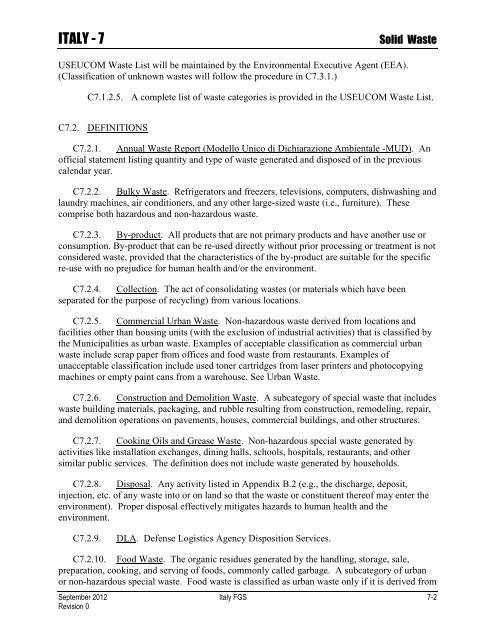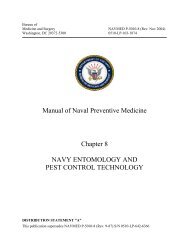ENVIRONMENTAL FINAL GOVERNING STANDARDS ITALY
ENVIRONMENTAL FINAL GOVERNING STANDARDS ITALY
ENVIRONMENTAL FINAL GOVERNING STANDARDS ITALY
Create successful ePaper yourself
Turn your PDF publications into a flip-book with our unique Google optimized e-Paper software.
<strong>ITALY</strong> - 7 Solid Waste<br />
USEUCOM Waste List will be maintained by the Environmental Executive Agent (EEA).<br />
(Classification of unknown wastes will follow the procedure in C7.3.1.)<br />
C7.1.2.5. A complete list of waste categories is provided in the USEUCOM Waste List.<br />
C7.2. DEFINITIONS<br />
C7.2.1. Annual Waste Report (Modello Unico di Dichiarazione Ambientale -MUD). An<br />
official statement listing quantity and type of waste generated and disposed of in the previous<br />
calendar year.<br />
C7.2.2. Bulky Waste. Refrigerators and freezers, televisions, computers, dishwashing and<br />
laundry machines, air conditioners, and any other large-sized waste (i.e., furniture). These<br />
comprise both hazardous and non-hazardous waste.<br />
C7.2.3. By-product. All products that are not primary products and have another use or<br />
consumption. By-product that can be re-used directly without prior processing or treatment is not<br />
considered waste, provided that the characteristics of the by-product are suitable for the specific<br />
re-use with no prejudice for human health and/or the environment.<br />
C7.2.4. Collection. The act of consolidating wastes (or materials which have been<br />
separated for the purpose of recycling) from various locations.<br />
C7.2.5. Commercial Urban Waste. Non-hazardous waste derived from locations and<br />
facilities other than housing units (with the exclusion of industrial activities) that is classified by<br />
the Municipalities as urban waste. Examples of acceptable classification as commercial urban<br />
waste include scrap paper from offices and food waste from restaurants. Examples of<br />
unacceptable classification include used toner cartridges from laser printers and photocopying<br />
machines or empty paint cans from a warehouse. See Urban Waste.<br />
C7.2.6. Construction and Demolition Waste. A subcategory of special waste that includes<br />
waste building materials, packaging, and rubble resulting from construction, remodeling, repair,<br />
and demolition operations on pavements, houses, commercial buildings, and other structures.<br />
C7.2.7. Cooking Oils and Grease Waste. Non-hazardous special waste generated by<br />
activities like installation exchanges, dining halls, schools, hospitals, restaurants, and other<br />
similar public services. The definition does not include waste generated by households.<br />
C7.2.8. Disposal. Any activity listed in Appendix B.2 (e.g., the discharge, deposit,<br />
injection, etc. of any waste into or on land so that the waste or constituent thereof may enter the<br />
environment). Proper disposal effectively mitigates hazards to human health and the<br />
environment.<br />
C7.2.9. DLA. Defense Logistics Agency Disposition Services.<br />
C7.2.10. Food Waste. The organic residues generated by the handling, storage, sale,<br />
preparation, cooking, and serving of foods, commonly called garbage. A subcategory of urban<br />
or non-hazardous special waste. Food waste is classified as urban waste only if it is derived from<br />
September 2012 Italy FGS 7-2<br />
Revision 0
















